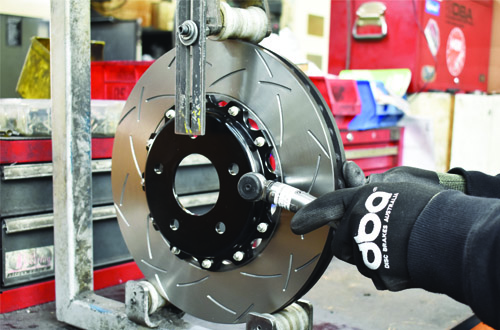This is a common topic that comes up in performance car discussions all the time. Unfortunately, there isn’t a simple answer for all applications so we will cover some of the important details to allow you to make an educated decision.
A typical front disc rotor on a large sedan is approximately 300mm (12in) in diameter and weighs around 9.5kg (21 lbs). We’ll focus on the front disc as it generally takes 70% of the braking load. A disc rotor consists of two main components, the mounting bell which attaches to the axle and the braking band (ring) to which the brake torque is applied via the caliper. The braking band or ring in this disc rotor weighs approximately 6kg. In the above-mentioned brake application this 9.5kg disc will increase in temperature by approximately 125 deg C (257 F) in just less than 5 seconds.

If the same 300mm disc weighed 8.5kg (18.7 lbs) with a braking band of 5.5kg then the temperature increase would be closer to 137 deg C (279 F). 10% increase in temperature doesn’t sound all that much but unfortunately heat transfer isn’t all that simple. In a one-off braking application an additional 10% probably wouldn’t make a noticeable difference. But what happens in performance driving on or off the track is a series of brake applications at regular intervals. The time between brake applications is rarely enough to allow the disc to recover to the optimal braking temperature so you end up with an accumulation of temperature build up over a period of time. 10% plus 10% plus 10% now becomes an issue!
Performance fanatics talk about reducing unsprung weight. Yes, a rotating disc does have a certain amount of rotating inertia or a flywheel effect which requires power to accelerate and to decelerate. It takes approximately 24 Nm (18 lbf-ft) of torque to get those 9.5kg disc spinning up to 134km/h (80 mph) and back down to zero when braking. The lighter 8.5kg disc requires approximately 20.5 Nm (15.1 lbf-ft) which is a little better than 10% saving in energy required to accelerate and decelerate the same vehicle. On a 6 litre Holden Monaro with 542 Nm (400 lbf ft) of torque you probably won’t notice a 3.5Nm improvement in torque whereas on an ultra-light, small performance car or race car you may.
Generally a car manufacturer will do all the math explained here and much more to determine the ideal disc mass (weight) for the vehicle and we can assure you it isn’t in their best interests to add weight to their vehicles or give away unnecessary kg’s of metal.
By thinking smarter DBA has developed opportunities to reduce weight without reducing performance by using higher quality disc rotor materials like DBA’s performance range or by replacing stock rotors with two piece designs such as DBA’s 5000 series discs which reduce weight from the mounting bell while maintaining the optimal weight on the braking band.